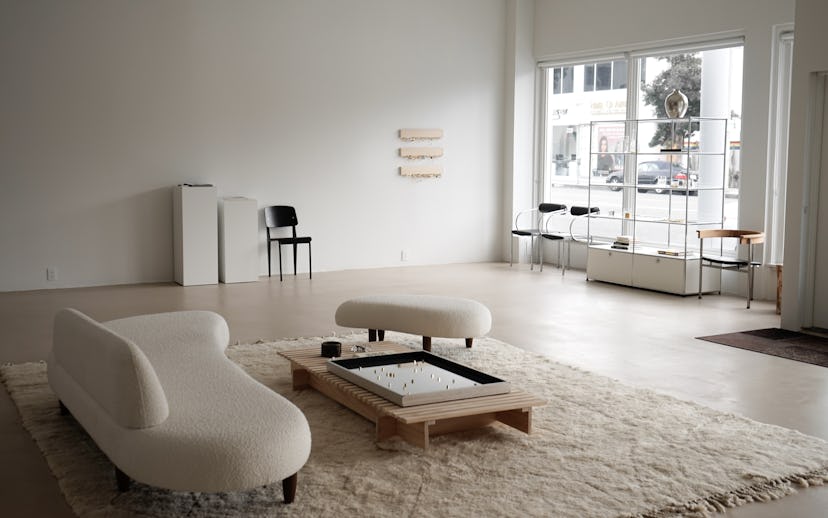
Fashion
What's The Future Of Experiential Retail?
Post-pandemic shopping ventures are about to be even more experience-focused — both online and in stores.
As many retail shops shutter for good, including more than 3,000 clothing, footwear, and accessories stores since the start of the pandemic last year, Jessie Andrews recently opened up a new one on Melrose Avenue in Los Angeles in February. Tase Gallery stocks all four of her successful direct-to-consumer businesses — Bagatiba jewelry, Basic Swim, Jeu Illimite ready-to-wear, and Petiue skin care — but this new venture is not your average brick and mortar.
Tase Gallery is an experiential store aiming to be the future of “art, community, and retail,” according to Andrews. In a time when the future of physical retail is uncertain, she predicts it will include even more immersive interactions, storytelling, and art exhibitions. While her brands are stocked and available at the new locale, many won’t actually be on display, which will help facilitate online pickups and encourage customers to use iPads to browse the brands' full selections.
“I think the future of retail is to keep intriguing and making people want to come back, changing the installations and having events and hosting artists,” Andrews tells NYLON. “When I go into a store, I'm bored. I really enjoy art and experience rather than just shopping.”
Andrews likens her new space to a more experiential Dover Street Market, with current installations and interactive moments spanning from a chandelier of rings and sand to dig through to find your letter block initial to looking at detailed beads through a microscope of water and using a photocopier to create zine-inspired art. Tase Gallery's upcoming exhibitions will include fashion photographer Hugo Comte, opening Feb. 25, and a Women's Month exhibition highlighting artists like Pegah Farahmand and Juliet Johnstone, opening March 4.
While Andrews hopes that Tase Gallery will become a cultural hub, there's no denying that her new business has been set up for success after spending most of her time in quarantine focused on building her brands via e-commerce. This is part of a larger shift to online shopping, accelerated by social media and, more recently, the pandemic. In fact, market research company eMarketer predicts that e-commerce sales will reach 14.4% of all U.S. retail spending this year and 19.2% by 2024.
This surge has caused a rising interest in experiential retail specifically for online shopping. Neha Singh, the founder and CEO of the virtual store platform Obsess, tells NYLON that, since last year, she has seen a 400% increase in inbound interest from brands and rapid growth in business from new and existing clients.
“Before the pandemic, we primarily had innovation teams inquiring about virtual stores,” she says. “Since then, the interest is coming from retail teams, visual merchandising and visual experience teams, marketing, wholesale, and digital teams, as virtual stores have gone from being a nice-to-have to a need.”
Singh says that the last five years have already been about experiential retail, but she predicts that the next five will be focused on experiential e-commerce. “Brands have realized that their website is the new flagship store,” she says. “In order to engage customers, especially the younger generation that is used to visual and interactive digital experiences with social and gaming, they need to upgrade their e-commerce interface.”
Obsess creates virtual stores for brands in two ways: photographing their physical retail store and making it shoppable online or creating a completely digital design and rendering the store in 3D. The latter leaves more room for a creative and immersive experience. “Virtual stores can be underwater, at rooftop pool parties, at yoga studios, or anywhere the brand wants,” Singh explains.
However, the opening of Tase Gallery and the insight from physical retail stores that have weathered the storm of the pandemic would suggest that the experiential future won’t be entirely online. Maggie Smith, senior vice president of brand and marketing at WS Development, the development company behind Boston’s largest single real estate endeavor in history, Seaport, says the outdoor mall has opened 10 new stores since the pandemic hit. The reason, she says, is the increased desire for community spaces.
“In-person shopping remains strong. In a Seaport survey, we learned that 86% of shoppers visited a store recently,” she tells NYLON. “That said, what’s missing is community — the antidote to the isolation in which people have been living. Pre-pandemic, great retail was already a place for shared experiences, and once the vaccine takes hold, we believe people will flock back to that setting for the connection they’ve been missing.”
An undeniable element of Seaport’s resilience during the pandemic has been its outdoor areas, with an increased interest in open-air dining. “Safety has really dominated the shifts in consumer habits that we’ve seen,” she says. “People want to feel connected but they also want to feel good about being in a public environment.” Their usually robust calendar of in-person events, including fitness classes and concerts, has gone virtual, since launching an online Seaport Sessions series hosting creative conversations last year.
What’s evident is that community spaces with a more photogenic, experiential focus catering to the Instagram and TikTok audiences will be a more appealing post-pandemic shopping experience and set the tone for the future of retail. However, after a year of limited in-person shopping and increased safety concerns, we’re still a while away from enjoying many of the perks, including events and community connection.
Instead, in order to stay relevant, brands will have to keep up with the expanding creative online market, making e-commerce purchases easy and enjoyable. For physical retail, it might take more to convince consumers to leave their houses. This could take shape with more gallery-shop hybrids or more outdoor-based retail. Whatever the future holds, it’s clear that online shopping will only continue to grow and traditional stores will have to further rethink and integrate their digital and physical experiences in order to avoid becoming obsolete.
This article was originally published on